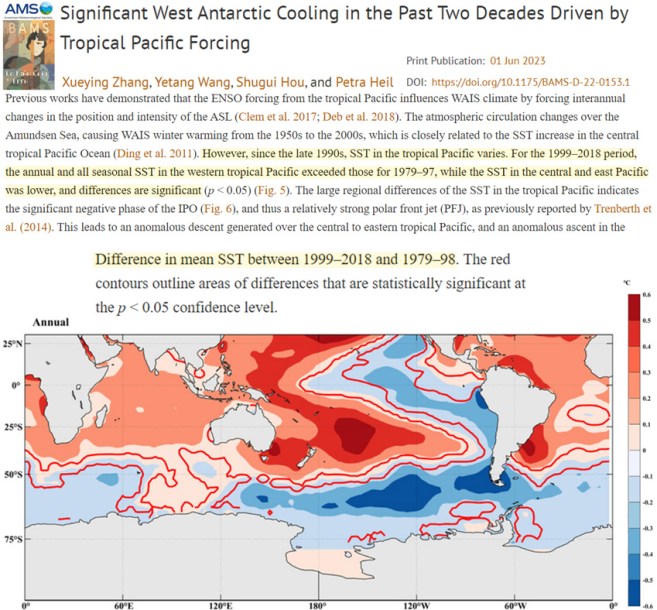Most Of Antarctica Has Cooled By Over 1°C Since 1999

Significant 21st-century cooling in the Central Pacific, Eastern Pacific, and nearly all of Antarctica “implies substantial uncertainties in future temperature projections of CMIP6 models.” – Zhang et al., 2023
New research indicates West Antarctica’s mean annual surface temperatures cooled by more than -1.8°C (-0.93°C per decade) from 1999-2018. In spring, the West Antarctic Ice Sheet (WAIS) cooling rate reached -1.84°C per decade.
Not only has the WAIS undergone significant cooling in the last two decades, but most of the continent has also cooled by more than 1°C.
See, for example, the ~1°C per decade cooling trend for East Antarctica (2000 to 2018) shown in Fig. ES1.
Of 28 CMIP6 models, none captured a cooling trend – especially of this amplitude – for this region. This modeling failure “implies substantial uncertainties in future temperature projections of CMIP6 models.”

Fig. ES1. Image Source: Zhang et al., 2023
The post-1999 cooling trend has not been confined to Antarctica.
Sea surface temperatures (SSTs) in the Eastern and Central Pacific (south of 25°N) also cooled from 1999-2018 relative to 1979-1997.
This cooling encompasses nearly half of the Southern Hemisphere’s SSTs.

Image Source: Zhang et al., 2023
The 1999-2018 mean annual surface temperature cooling of the Antarctic continent and nearly half of the Southern Hemisphere’s SSTs do not support the claims that surface warming is driven by human emissions of ‘greenhouse gases’.
After all, if the increase in ‘GHG forcing’ can’t explain the widespread cooling, why would the same concentrations of ‘GHG’s explain the areas with warming temperatures?
See more here climatechangedispatch
Header image: Earth-Sky
Please Donate Below To Support Our Ongoing Work To Defend The Scientific Method
PRINCIPIA SCIENTIFIC INTERNATIONAL, legally registered in the UK as a company  incorporated for charitable purposes. Head Office: 27 Old Gloucester Street, London WC1N 3AX.
incorporated for charitable purposes. Head Office: 27 Old Gloucester Street, London WC1N 3AX.
Trackback from your site.
